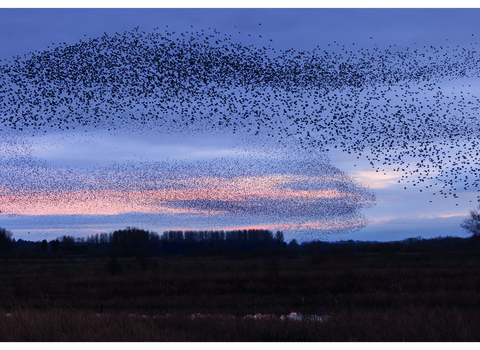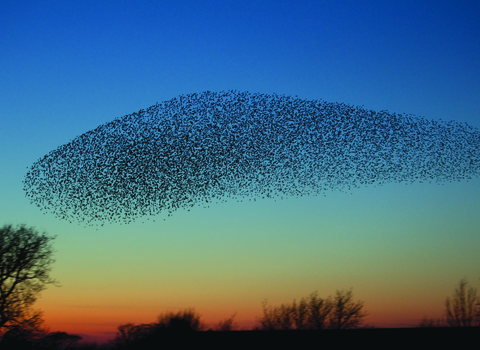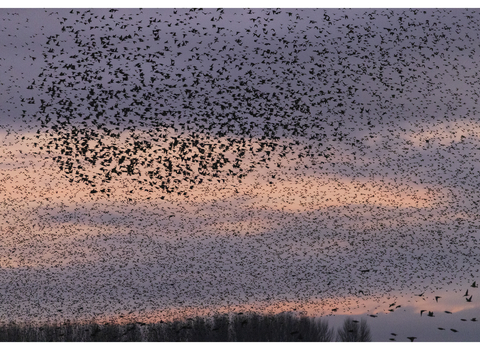You find yourself out on a walk as winter dusk sets on when without warning, calm skies are suddenly filled with a whirling, liquid-like mass of birds, moving in stunning synchronicity. This is a starling murmuration, one of nature’s awe-inspiring spectacles and still shrouded in a little mystery.
Common starlings are one of Yorkshire’s most familiar birds, yet many don’t fully appreciate their dazzling qualities. Starlings have fantastic plumage which changes from a glossy green, black and purple sheen during summer to a stunning dark speckled white in winter, making them one of our loveliest and underrated sights – and even moreso when they gather in flocks.
Autumn roosts usually begin to form in November, and last until early January. More and more birds will flock together as the weeks go on, and the number of starlings in a roost can swell to around 100,000 in some places.
Describing a starling murmuration rarely does it justice – the best thing is to see it for yourself. Read on to discover the best places in Yorkshire to experience this incredible aerial display.

Ripon City Wetlands
Ripon City Wetlands is an excellent place to see starling murmurations during autumn and winter months. This amazing spectacle takes place just before dusk. Leave plenty of time to walk from your car so you don’t miss the action. Murmurations here are usually best at the north end of the reserve by the riverside lagoon screen and the sand martin bank.
Warning: The car park gate is closed from 4pm until 9am for both vehicles and pedestrians – don't get locked in.
Out of hours parking is available on Boroughbridge Road before the bridge - park here if you're going to return to your vehicle after 4pm. An out of hours walking route is also available via the river or canal towpath. Please use this route to enter or exit the reserve after 4pm as the main car park gate is closed for both vehicle and pedestrian access.
Warning: Ripon City Wetlands is prone to flooding over the winter. The site will be closed completely and inaccessible when flooded, as the waters can put the entire nature reserve underwater.
Potteric Carr
Potteric Carr is known nationally for murmurations, as up to 50,000 starlings visit Potteric Carr between November and January. With acres of sky above you, and the promise of a hot drink in the on-site café afterwards, it’s worth braving winter’s chill to see a murmuration in action.
Please note that Potteric Carr's car park is locked at 5pm - if you would like to stay later, please arrive before 5pm and ask at the centre's reception desk. The cafe is open from 9am until 4pm. Entrance to Potteric Carr is free for Wildlife Trust members, £5 for adults and £4 for children, or £12 for a family.

Danny Green / 2020VISION
Staveley
Although rarer, we do occasionally get wonderful murmurations at Staveley too! These are best viewed from the central hill on the reserve, which offers fantastic views out across the surrounding landscape and a huge clear sky to watch the spectacle.
There is a car park big enough for 12 cars just off Miniskip Road. Disabled parking is available off Main Street, up the track by the village church, and you can access this with a Radar key. If you park in the car park or elsewhere, please do so considerately and safely and with respect to local residents and other road users.
How to watch murmurations safely
Starlings are wild creatures, so we can’t always guarantee you’ll see a murmuration. You may have to try a few times to see one. We recommend arriving as early as possible and enjoying the other wildlife on site in case the starlings don’t display.
- Make sure to wrap up warm - really warm. It can get surprisingly chilly standing waiting by a wintery reedbed, but it will be worth it, we promise.
- Many of our reserves have uneven and sometimes muddy paths underfoot - especially in the winter! These can become more difficult to navigate at dusk or dark. Make sure to wear sensible and sturdy footwear, and bring a torch to light your way home.
- Arrive at least half an hour before the sun goes down, or even a bit earlier, and find a good vantage point where you can see both the roost site and the sky above.
- Please take note of when reserve car parks open and close, and park sensibly. Follow all relevant signage on reserves.

